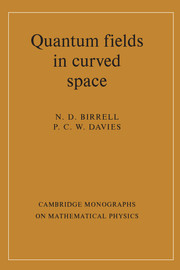Book contents
- Frontmatter
- Contents
- Preface
- Preface to the paperback edition
- Conventions and abbreviations
- 1 Introduction
- 2 Quantum field theory in Minkowski space
- 3 Quantum field theory in curved spacetime
- 4 Flat spacetime examples
- 5 Curved spacetime examples
- 6 Stress-tensor renormalization
- 7 Applications of renormalization techniques
- 8 Quantum black holes
- 9 Interacting fields
- References
- Index
Preface to the paperback edition
Published online by Cambridge University Press: 05 August 2012
- Frontmatter
- Contents
- Preface
- Preface to the paperback edition
- Conventions and abbreviations
- 1 Introduction
- 2 Quantum field theory in Minkowski space
- 3 Quantum field theory in curved spacetime
- 4 Flat spacetime examples
- 5 Curved spacetime examples
- 6 Stress-tensor renormalization
- 7 Applications of renormalization techniques
- 8 Quantum black holes
- 9 Interacting fields
- References
- Index
Summary
Since the book first went to press, there have been several important advances in this subject area. The topic of interacting fields in curved space has been greatly developed, especially in connection with the phenomenon of symmetry breaking and restoration in the very early universe, where both high temperatures and spacetime curvature are significant. A direct consequence of this work has been the formulation of the so-called inflationary universe scenario, in which the universe undergoes a de Sitter phase in the very early stages. This work has focussed attention once more on quantum field theory in de Sitter space, and on the calculation of 〈φ2〉. A comprehensive review of the inflationary scenario is given in The Very Early Universe, edited by G.W. Gibbons, S.W. Hawking and S.T.C. Siklos (Cambridge University Press, 1983).
Further results of a technical nature have recently been obtained concerning a number of the topics considered in this book. Mention should be made of the work of M.S. Fawcett, who has finally calculated the quantum stress tensor for a Schwarzschild black hole (Commun. Math. Phys., 81 (1983), 103), and of W.G. Unruh & R.M. Wald, who have clarified the thermodynamic properties of black holes by appealing to the effects of accelerated mirrors close to the event horizon (Phys. Rev. D, 25 (1982), 942; 27 (1983), 2271). Interest has also arisen over field theories in higher-dimensional spacetimes, in which Casimir and other vacuum effects become important.
Information
- Type
- Chapter
- Information
- Quantum Fields in Curved Space , pp. viiiPublisher: Cambridge University PressPrint publication year: 1982
